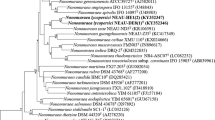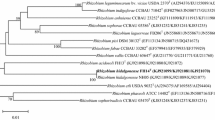Abstract
During a survey of Burkholderia species with potential use in agrobiotechnology, a group of 12 strains was isolated from the rhizosphere and rhizoplane of tomato plants growing in Mexico (Nepantla, Mexico State). A phylogenetic analysis of 16S rRNA gene sequences showed that the strains are related to Burkholderia kururiensis and Burkholderia mimosarum (97.4 and 97.1 %, respectively). However, they induced effective nitrogen-fixing nodules on roots of Phaseolus vulgaris. Based on polyphasic taxonomy, the group of strains represents a novel species for which the name Burkholderia caballeronis sp. nov. is proposed. The type species is TNe-841T (= LMG 26416T = CIP 110324T).

Similar content being viewed by others
References
Angus AA, Lee A, Lum MR, Shehayeb M, Hessabi R, Fujishige NA, Yerrapragada S, Kano S, Song N, Yang P, Estrada-de los Santos P, de Faria SM, Dakora FD, Weinstock G, Hirsch AM (2013) Nodulation and effective nitrogen fixation of Macroptilium atropurpureum (siratro) by Burkholderia tuberum a nodulating and plant growth promitng beta-proteobacterium, are influenced by environmental factors. Plant Soil 369:543–562
Anisimova M, Gascuel O (2006) Approximate likelihood-ratio test for branches: a fast, accurate, and powerful alternative. Syst Biol 55:352–539
Balandreau J, Mavingui P (2007) Beneficial interactions of Burkholderia spp. with plants. In: Coenye T, Vandamme P (eds) Burkholderia: molecular microbiology and genomics. Horizon Bioscience, Norfolk, pp 129–151
Caballero-Mellado J, Martnez-Aguilar L, Paredes-Valdez G, Estrada-de los Santos P (2004) Burkholderia unamae sp nov., an N2-fixing rhizospheric and endophytic species. Int J Syst Evol Microbiol 54:1165–1172
Caballero-Mellado J, Onofre-Lemus J, Estrada-de los Santos P, Martinez-Aguilar L (2007) The tomato rhizosphere, an environment rich in nitrogen-fixing Burkholderia species with capabilities of interest of agriculuture and bioremediation. Appl Environ Microbiol 73:5308–5319
Chen WM, Moulin L, Bontemps C, Vandamme P, Bena G, Boivin-Masson C (2003) Legume symbiotic nitrogen fixation by b-proteobacteria is widespread in nature. J Bacteriol 185:7266–7272
Chen WM, James EK, Coenye T, Chou JH, Barrios E, de Faria SM, Elliott GN, Sheu SY, Sprent JI, Vandamme P (2006) Burkholderia mimosarum sp. nov., isolated from root nodules of Mimosa spp. from Taiwan and South America. Int J Syst Evol Microbiol 56:1847–1851
Chen WM, de Faria SM, James EK, Elliott GN, Lin KY, Chou JH, Sheu SY, Cnockaert M, Sprent JI, Vandamme P (2007) Burkholderia nodosa sp. nov., isolated from root nodules of the woody Brazilian legumes Mimosa bimucronata and Mimosa scabrella. Int J Syst Evol Microbiol 57:1055–1059
Chen WM, de Faria SM, Chou JH, James EK, Elliot GN, Sprent JI, Bontemps C, Young JPW, Vandamme P (2008) Burkholderia sabiae sp. nov. isolated from root nodules of Mimosa caesalpiniifolia. Int J Syst Evol Microbiol 58:2174–2179
De Meyer SE, Cnockaert M, Ardley JK, Maker G, Yates R, Howieson JG, Vandamme P (2013a) Burkholderia sprentiae sp. nov. isolated from Lebeckia ambigua root nodules from South Africa. Int J Syst Evol Microbiol. doi:10.1099/ijs.0.048777-0
De Meyer SE, Cnockaert M, Ardley JK, Trengove RD, Garau G, Howieson JG, Vandamme P (2013b) Burkholderia rhynochosiae sp. nov. isolated from Rhynchosia ferulifolia root nodules from South Africa. Int J Syst Evol Microbiol. doi:10.1099/ijs.0.048751-0
de Oliveira-Cunha C, Goda-Zuleta LF, de Almeida LGP, Prioli-Ciapina L, Borges WL, Pitard RM, Baldani JI, Straliotto R, de Faria SM, Hungria M, Sousa-Cavada B, Martinis-Mercante F, de Ribeiro Vasconcelos AT (2012) Complete genome sequence of Burkholderia phenoliruptrix BR3459a (CLA1), a heat-tolerant, nitrogen-fixing symbiont of Mimosa flocculosa. J Bacteriol 194:6675–6676
Denef V (2007) Biodegradation of organic anthropogenic pollutants by Burkholderia species. In: Coenye T, Vandamme P (eds) Burkholderia: molecular microbiology and genomics. Horizon Bioscience, Norfolk, pp 177–201
Edgar RC (2004) MUSCLE: multiple sequence alignment with high accuracy and high throughput. Nucleic Acids Res 32:1792–1797
Estrada-de los Santos P, Bustillos-Cristales R, Caballero-Mellado J (2001) Burkholderia, a genus rich in plant-associated nitrogen fixers with wide environmental and geographic distribution. Appl Environ Microbiol 67:2790–2798
Estrada-de los Santos P, Vacaseydel-Aceves NB, Martinez-Aguilar L, Cruz-Hernandez MA, Mendoza-Herrera A, Caballero-Mellado J (2011) Cupriavidus and Burkholderia species associated with agricultural plants that grow in alkaline soils. J Microbiol 49:867–876
Estrada-de los Santos P, Martínez-Aguilar L, Vinuesa P, Hirsch AM, Caballero-Mellado J (2013) Phylogenetic analysis of Burkholderia species by Multilocus sequence analysis. Curr Microbiol 67:51–60
Fahraeus G (1957) The infection of clover root hairs by nodule bacteria studied by a simple slide technique. J Gen Microbiol 16:379–381
Ferreira PAA, Bomfeti CA, Lima Soares B, de Souza Moreira FM (2012) Efficient nitrogen-fixing Rhizobium strains isolated from amazonian soils are highly tolerant to acidity and aluminium. World J Microbiol Biotechnol 28:1947–1959
Gillis M, Van TV, Bardin R, Goor M, Hebbar P, Willems A, Segers P, Kersters K, Heulin T, Fernandez MP (1995) Polyphasic taxonomy in the genus Burkholderia leading to an emended description of the genus and proposition of Burkholderia vietnamiensis sp. nov. for N2-fixing isolates from rice in Vietnam. Int J Syst Bacteriol 45:274–289
Goris J, de Vos P, Caballero-Mellado J, Park J, Falsen E, Quensen JF III, Tiedje JM, Vandamme P (2004) Classification of the biphenyl- and polychlorinated biphenyl-degrading strain LB400T and relatives as Burkholderia xenovorans sp. nov. Int J Syst Evol Microbiol 54:1677–1681
Guindon S, Gascuel O (2003) A simple, fast, and accurate algorithm to estimate large phylogenies by maximum likelihood. Syst Biol 52:696–704
Gyaneshwar P, Hirsch AM, Chen WM, Elliott GN, Bontemps C, Gross E, dos Reis Junior FB, Sprent JI, Young JPW, James EK (2011) Legume nodulating β-proteobacteria: diversity, host range and future prospects. Mol Plant-Microbe Int 24:1276–1288
Hauser AR, Jain M, Bar-Meir M, McColley SA (2011) Clinical significance of microbial infection and adaptation in cystic fibrosis. Clin Microbiol Rev 24:29–70
Howieson JG, De Meyer SE, Vivas-Marfisi A, Ratnayake S, Ardley JK, Yates RJ (2013) Novel Burkholderia bacteria isolated from Lebeckia ambigua—a perennial suffrutescent lagume of the fynbos. Soil Biol Biochem 6:55–64
Kim OS, Cho YJ, Lee K, Yoon SH, Kim M, Na H, Park SC, Jeon YS, Lee JH, Yi H, Won S, Chun J (2012) Introducing EzTaxon-e: a prokaryotic 16S rRNA Gene sequence database with phylotypes that represent uncultured species. Int J Syst Evol Microbiol 62:716–721
Laemmli UK (1970) Cleavage of structural proteins during the assembly of the head of bacteriophage T4. Nature 227:680–685
Mascarua-Esparza MA, Villa-Gonzalez R, Caballero-Mellado J (1988) Acetylene reduction and indoleacetic acid production by Azospirillum isolates from cactaceous plants. Plant Soil 106:91–95
Mesbah M, Premachandran U, Whitman WB (1989) Precise measurement of the G + C content of deoxyribonucleic acid by high performance liquid chromathography. Int J Syst Bacteriol 39:159–167
Perin L, Martinez-Aguilar L, Castro-Gonzalez R, Estrada-de los Santos P, Cabellos-Avelar T, Guedes HV, Reis VM, Caballero-Mellado J (2006a) Diazotrophic Burkholderia species associated with field-grown maize and sugarcane. Int J Syst Evol Microbiol 72:3103–3110
Perin L, Martinez-Aguilar L, Paredes-Valdez G, Baldani JI, Estrada-de los Santos P, Reis VM, Caballero-Mellado J (2006b) Burkholderia silvatlantica sp. nov., a diazotrophic bacterium associated with sugarcane and maize. Int J Syst Evol Microbiol 56:1931–1937
Reis VM, Estrada-de los Santos P, Tenorio-Salgado S, Vogel J, Stoffels M, Guyon S, Mavingui P, Baldani VLD, Schmid M, Baldani JI, Balandreau J, Hartmann A, Caballero-Mellado J (2004) Burkholderia tropica sp. nov., a novel nitrogen-fixing, plantassociated bacterium. Int J Syst Evol Microbiol 54:2155–2162
Sheu SY, Chou JH, Bontemps C, Elliott GN, Gross E, James EK, Sprent JI, Young JPW, Chen WM (2012) Burkholderia symbiotica sp. nov., isolated from root nodules of Mimosa spp. native to north-east Brazil. Int J Syst Evol Microbiol 62:2272–2278
Sheu SY, Chou JH, Bontemps C, Elliot GN, Gross E, dos Reis Junior FB, Meldonian R, Moulin L, James EK, Sprent JI, Young JPW, Chen WM (2013) Burkholderia diazotrophica sp. nov., isolated from root nodules of Mimosa spp. Int J Syst Evol Microbiol 63:435–441
Suarez-Moreno ZR, Caballero-Mellado J, Coutinho BG, Mendonça-Previato L, James EK, Venturi V (2012) Common features of environmetal and potentially beneficial plant-associated Burkholderia. Microb Ecol 63:249–266
Tamura K, Peterson D, Stecher G, Nei M, Kumar S (2011) MEGA 5: molecular evolutionary genetics analysis using maximum likelihood, evolutionary distances, and maximum parsimony methods. Mol Biol Evol 28:2731–2739
Tindall BJ, Rosello-Mora R, Busse HJ, Ludwing W, Kampfer P (2011) Notes on the characterization of prokaryote strains for taxonomic purposes. Int J Syst Evol Microbiol 60:249–266
Vandamme P, Pot B, Gillis M, de Vos P, Kersters K, Swings J (1996) Polyphasic taxonomy, a consensus approach to bacterial systematics. Microbiol Rev 60:407–438
Vandamme P, Goris J, Chen WM, de Vos P, Willems A (2002) Burkholderia tuberum sp. nov. and Burkholderia phymatum sp. nov., nodulate the roots of tropical legumes. Syst Appl Microbiol 25:507–512
Versalovic J, Schneider M, de Bruijn FJ, Lupski JR (1994) Genomic fingerprinting of bacteria using repetitive sequence based polymerase chain reaction. Meth Mol Cell Biol 5:25–40
Weisburg WG, Barns SM, Pelletier DA, Lane DJ (1991) 16S ribosomal DNA amplification for phylogenetic study. J Bacteriol 173:697–703
Wilson K (1987) Preparation of genomic DNA from bacteria. In: Ausubel FM, Brent R, Kingston RE, Moore DD, Seidman JG, Smith JA, Struhl K (eds) Current protocols in molecular biology. Greene Publishing and Wiley-Interscience, New York, pp 2.4.1–2.4.5
Yang Z (1996) Among-site rate variation and its impact on phylogenetic analyses. Trends Ecol Evol 11:367–372
Zhang H, Hanada S, Shigematsu T, Shibuya K, Kamagata Y, Kanagawa T, Kurane R (2000) Burkholderia kururiensis sp. nov., a trichloroethylene (TCE)-degrading bacterium isolated from an aquifer polluted with TCE. Int J Syst Evol Microbiol 50:743–749
Acknowledgments
We are indebted to Dr. Euzeby for the etymological construction of the new bacteria species. We are grateful to Marco Antonio Rogel Hernández (Centro de Ciencias Genómicas, UNAM) for technical support. NSF IOS-0747525, IOS 1201735, and the Shanbrom Family Foundation support Burkholderia research in the Hirsch laboratory.
Author information
Authors and Affiliations
Corresponding author
Electronic supplementary material
Below is the link to the electronic supplementary material.
Rights and permissions
About this article
Cite this article
Martínez-Aguilar, L., Salazar-Salazar, C., Méndez, R.D. et al. Burkholderia caballeronis sp. nov., a nitrogen fixing species isolated from tomato (Lycopersicon esculentum) with the ability to effectively nodulate Phaseolus vulgaris . Antonie van Leeuwenhoek 104, 1063–1071 (2013). https://doi.org/10.1007/s10482-013-0028-9
Received:
Accepted:
Published:
Issue Date:
DOI: https://doi.org/10.1007/s10482-013-0028-9




